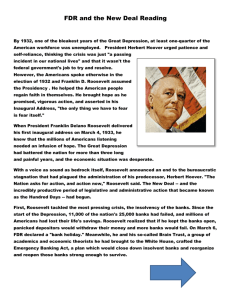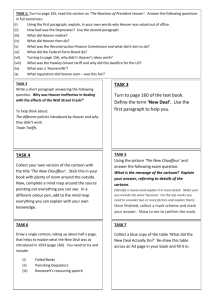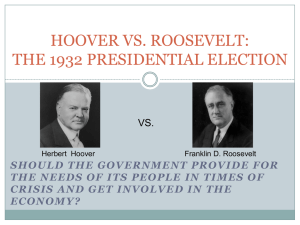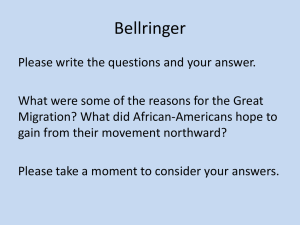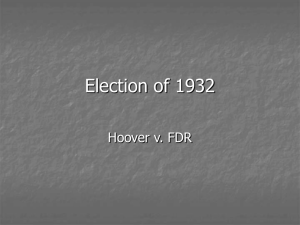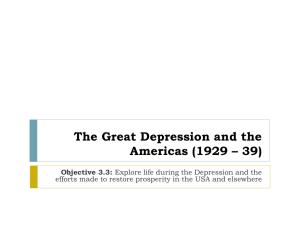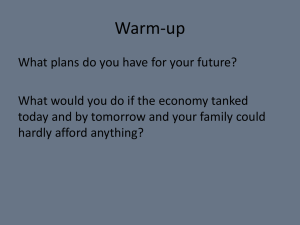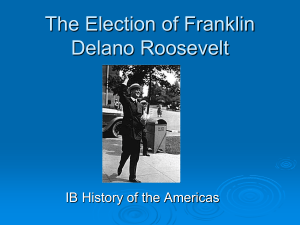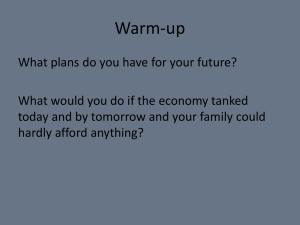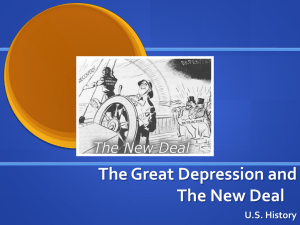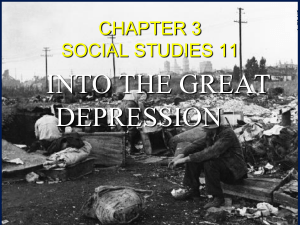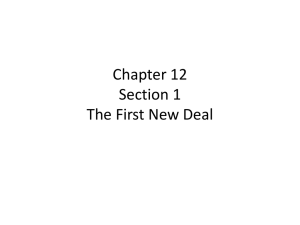FDR and the Great Depression _1_ diskey
advertisement
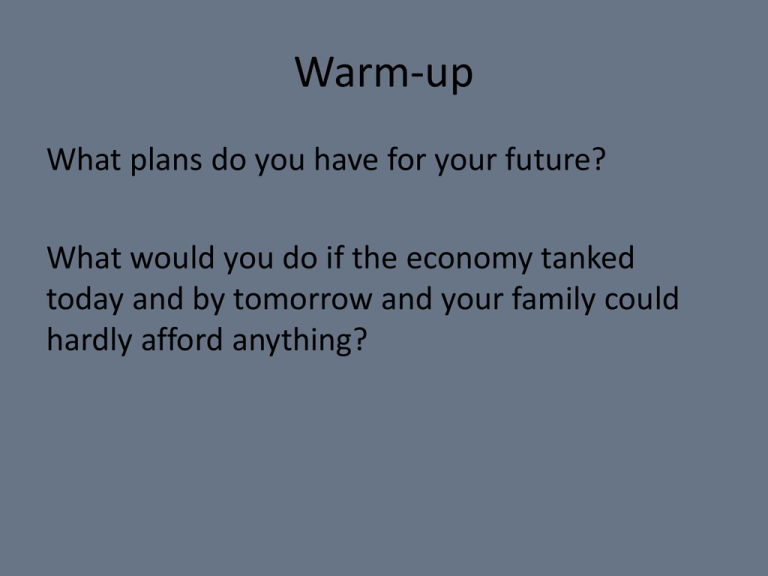
Warm-up What plans do you have for your future? What would you do if the economy tanked today and by tomorrow and your family could hardly afford anything? FDR and the Great Depression Election of 1928 Herbert Hoover who was part of the Coolidge administration ran against Alfred E. Smith of the Democratic party. Hoover said that the wealth and prosperity of the 1920’s was due to the actions of the republican party. This would be how he won the election CAUSES OF THE GREAT DEPRESSION • Tariffs & war debt policies • U.S. demand low, despite factories producing more • Farm sector crisis • Easy credit • Unequal distribution of income Causes of the Depression The twenties saw a boom in consumer spending. As people began to but more durable good such as cars, and refrigerators production began to peter off. Due to the fact that people did not need multiples of these items. Causing a brief recession in 1920s Problems continue to build Not heeding these signs the government continued to make it easier for banks to take out loans. The hope was to stimulate the economy Individuals with excess cash began investing in stock. During the time the market moved in spurts of success. SEEDS OF TROUBLE • By the late 1920s, problems with the economy emerged • Speculation: Too many Americans were engaged in speculation – buying stocks & bonds hoping for a quick profit • Margin: Americans were buying “on margin” – paying a small percentage of a stock’s price as a down payment and borrowing the rest The Stock Market’s bubble was about to break Bull market A Bull market is usually defined as a market on the rise. This rising market only lead more people to invest their money. THE 1929 CRASH • In September the Stock Market had some unusual up & down movements • On October 24, the market took a plunge –”Black Thursday” the worst was yet to come • On October 29, now known as Black Tuesday, the bottom fell out • 16.4 million shares were sold that day – prices plummeted • People who had bought on margin (credit) were stuck with huge debts Bank Runs As the stock market crashed people went to the banks to pull their money out of the banks. Do to a fear of a loss of their money. Banks could not handle so many people pulling money out and did not have enough money to give to people The result was the collapse of banks. Unemployment By 1932 the unemployment in the country grew to 25 percent. The unemployed stood in lines for hours looking for relief check. Some left the city for the country, but still found little hope. FARMERS STRUGGLE • No industry suffered as much as agriculture • During World War I European demand for American crops soared • After the war demand plummeted • Farmers increased production sending prices further downward Photo by Dorothea Lange Haley Smoot Tariff Hoover and Voluntarism Hoover who had a lot of promise as a President was unprepared for the depression. He told the public good things are right around the corner as he supported rugged individualism. Rugged Individualism: the belief that Americans could improve their own standing if they worked hard. He pushed fro charities to give relief, but refused to provide federal funding when supplies ran out. Taking action As Hoover saw his attempts fall apart he began to take action to change the economy. Loaned money to cooperatives and bought access crops. Created the RFC to help banks. Pushed for the cutting of taxes and built the Hoover dam. Continued Social Reform When congress came together in 1935 congress was reminded that it had not provided a welfare system for its aged and disabled. Eventually this would become the social security act Provided old age pensions Set up a system of unemployment Provided federal grants for state welfare. Roosevelt and the New Deal 1932 the Republicans nominate Herbert Hoover The Democrats Nominate FDR who proposes the new Deal in his acceptance speech The New Deal: A name for the policies that Roosevelt would use to end the depression. Election 1932 Roosevelt’s optimism in the future was a stark contrast to Hoover’s failure. With this perception Roosevelt won by a land slide. Activity Write down the following two questions then use the speech that follows to answer the questions. 1.Why does Roosevelt think that “nameless, unreasoning, unjustified terror” is such a big problem? 2.What does the President feel is the nations primary task. How diligent should they be in it. Inaugural Address This is preeminently the time to speak the truth, the whole truth, frankly and boldly. Nor need we shrink from honestly facing conditions in our country today. This great Nation will endure as it has endured, will revive and will prosper. So, first of all, let me assert my firm belief that the only thing we have to fear is fear itself—nameless, unreasoning, unjustified terror which paralyzes needed efforts to convert retreat into advance. Our greatest primary task is to put people to work. This is no unsolvable problem if we face it wisely and courageously. It can be accomplished in part by direct recruiting by the Government itself, treating the task as we would treat the emergency of a war The Gold Standard One of the first things Roosevelt did was end the Gold standard The gold standard equated an once of gold to a certain amount of dollars. As the dollar value dropped the people began to cash their money in for gold Confiscating Gold Roosevelt ended the Gold standard and began to collect people’s gold. This was to increase the value of the dollar. It was illegal to have more than a certain amount of Gold. Bank Holiday Banks continued to collapse especially due to the end of gold standard. Governors created the idea of bank holiday. It closed the banks giving them time to seek relief Roosevelt agreed and would help restructure banks. The First Hundred Days The new president sent bill after bill to congress By the end of the first hundred days the president passed 15 bills to help the economy. Fireside Chats As the President worked to restore the banks he used to technology to reassure citizens. Roosevelt took to the radio explaining to the people what his plans were for banks. As well as reassure the American people. FDIC and SEC SEC: Securities and Exchange Commission: Existed to manage the stock market and prevent fraud. FDIC: Federal Deposit Insurance Corporation provide government insurance for bank deposits. Built confidence in the bank system. HOLC and FCA HOLC: Home Owners Loan Corporation: Helped homeowners pay their mortgage. FCA: The Farm Credit Administration: Help farmers refinance their mortgages. The AAA and NRA AAA: Agricultural Adjustment Administration, worked to adjust farm prices. NRA: National Recovery Administration: Lead by Hugh Johnson Business owners signed a pledge to sell government products that pushed fair labor environments. Unfortunately the NRA was considered unconstitutional by the Supreme Court and was removed. The CCC and PWA CCC: The Civilian Conservation Corps: Gave young men age 18-25 the chance to work with the forestry service to plant trees and fight forest fires. PWA: Public Works Administration: Most of the those unemployed worked in construction. Gave jobs on buildings, sewers, dams, schools, highways. Critics of the President Many criticized the new deal for deficit spending. Essentially they worried that the President had barrowed too much money instead of balancing the budget. Opposition to the New deal Floyd Olsen led a group of mid west farming progressives looking for real change in the system Father Charles Coughlin originally supported the new deal eventually he turned looking to nationalizing the banking system Huey long: developed the idea of share the wealth clubs. WPA The Works Progress Administration: Headed by Harry Hopkins was the largest publics work program of the New Deal Employed workers to build roads and highways. Wagner Act As the New Deal expanded it continued to help certain groups such as labor groups The Wagner act outlawed company unions and unfair labor practices to ensure collective bargaining. This would lead to the national labor relations board and a fair labor and standards act passed in 1938 Look at pages 663-667 What groups did the New Deal help and who were some of the key leaders of these groups. First Hundred Days
